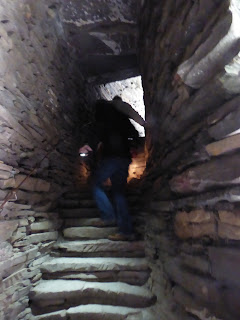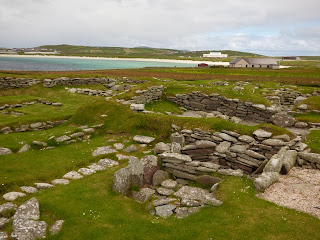Next morning, bright and early we collected John and Jordanna at 9am.
Then it was back along the road towards Sumburgh, but we would not be going that far.
Our place to visit today was the little island of Mousa, because on this island there stands the almost complete Mousa Broch, built over 2000 years ago.
The ferry leaves from the little harbour at Sandsayre. While you are waiting there is a small museum telling the history of the area.
Mousa is uninhabited. Its name means Mossy Island. It is old Norse. Today it is an RSPB site, but visitors are welcome as long as you keep to the signposted path, and follow the rules.
There are no facilities on the island. The ferry will leave you there for about 4 hours. So use the toilet at the pier before leaving. No shops, so bring food and suitable clothing.
I was not sure how we could spend 4 hours there, but in face we had a fascinating time, and at no point were we wishing for the ferry to return.
The sheep on the island were all assembled near the little jetty for shearing. You can imagine the noise.
We set off round the island admiring the views and the birds. There were seals to be seen and heard. I imagined what those cries would sound like in the middle of a dark night. Unnerving for sure.
Eventually we reached the broch. It can be seen from the mainland, but as you approach from the rear of the island you begin to appreciate the size. And as you get closer still, and then when you are actually inside it, you begin to appreciate the building skills of those men 2000 years ago.
It is the best preserved Iron Age roundhouse in existence and is mentioned in the Norse Sagas.
You can still climb up inside the circular walls to the top where you have a birds eye view all around you and over to the mainland.
So for animal loves and history lovers, Mousa is a must. Only open in the summer season, April to mid September.
http://www.mousa.co.uk/mousa-island-trip
https://en.wikipedia.org/wiki/Mousa
http://www.shetland-heritage.co.uk/mousa
http://www.rspb.org.uk/discoverandenjoynature/seenature/reserves/guide/m/mousa/
I am a recently retired Scottish Primary Teacher. I am married, 5 sons, 1 daughter. This blog comprises my photos and my thoughts for each day
Monday, 17 August 2015
Friday, 14 August 2015
Jarlshof
Our time on Shetland was limited, and so having spent some time at the Clickimon Broch, we headed back to the car and drove towards Sumburgh Head at the south of the Island.
Of course we had passed here on the ferry earlier that morning. It was about a 30 minute drive on a road that was very quiet.
Sumburgh is where the airport is, and the road actually crosses one of the runways, so if there are active aircraft, the road is temporarily closed. There is also a lighthouse that can be visited and a bird sanctuary. But we were going to visit Jarlshof.
On the shore, within view of the airport is the site of a Prehistoric Norse settlement, plus the remains of a 17th Century Laird's House.
This has to be one of the most interesting places I have ever visited.
We now know that people have lived her for over 4000 years. The last people were here in the 1600s.
Over that time, the evidence of all this settlement gradually disappeared under the wind blown sand.
Had you come here in early 1800, all you would have seen was a grassy mound and the ruins of a substantial house.
But then around 1829, a series of violent storms blew the sand away, and the extensive remains of a prehistoric broch and roundhouses and wheel houses were found, as well as a Viking settlement.
There is an audio tour available. We used it and highly recommend it.
For more information about Jarlshof, follow the links. There is too much to tell here.
If you are contemplating a visit, please note that the site, like many here, is only open from April to September.
http://www.historic-scotland.gov.uk/propertyresults/propertyoverview.htm?PropID=PL_162
https://en.wikipedia.org/wiki/Jarlshof
http://www.shetland-heritage.co.uk/jarlshof
http://www.educationscotland.gov.uk/scotlandshistory/britonsgaelsvikings/jarlshof/index.asp
Of course we had passed here on the ferry earlier that morning. It was about a 30 minute drive on a road that was very quiet.
Sumburgh is where the airport is, and the road actually crosses one of the runways, so if there are active aircraft, the road is temporarily closed. There is also a lighthouse that can be visited and a bird sanctuary. But we were going to visit Jarlshof.
On the shore, within view of the airport is the site of a Prehistoric Norse settlement, plus the remains of a 17th Century Laird's House.
This has to be one of the most interesting places I have ever visited.
We now know that people have lived her for over 4000 years. The last people were here in the 1600s.
Over that time, the evidence of all this settlement gradually disappeared under the wind blown sand.
Had you come here in early 1800, all you would have seen was a grassy mound and the ruins of a substantial house.
But then around 1829, a series of violent storms blew the sand away, and the extensive remains of a prehistoric broch and roundhouses and wheel houses were found, as well as a Viking settlement.
There is an audio tour available. We used it and highly recommend it.
For more information about Jarlshof, follow the links. There is too much to tell here.
If you are contemplating a visit, please note that the site, like many here, is only open from April to September.
http://www.historic-scotland.gov.uk/propertyresults/propertyoverview.htm?PropID=PL_162
https://en.wikipedia.org/wiki/Jarlshof
http://www.shetland-heritage.co.uk/jarlshof
http://www.educationscotland.gov.uk/scotlandshistory/britonsgaelsvikings/jarlshof/index.asp
Subscribe to:
Posts (Atom)











































































